
Steve Pietzch, “Ronald Reagan as Alfred E. Neuman”
The political moment needs to be right for political caricature to thrive. Whether it’s the corruption of Boss Tweed and Tammany Hall or the turmoil of the Great Depression and the World Wars, social upheaval has always provided the ink for the political cartoonist’s pen.
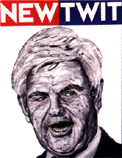
Robbie Conal, “Newtwit”
The second half of the 20th century started slow. With the notable exception of Robert Osborn’s unforgiving portraits in The New Republic and Herblock’s stinging commentaries in the Washington Post, political caricature was pretty lackluster during the Eisenhower and Kennedy administrations. It wasn’t until Lyndon Johnson expanded the Vietnam War that a new sense of indignation emerged and a new generation of independent visual commentators revived the moribund medium. The leaders of this generation — David Levine, Edward Sorel, and Robert Grossman — first apprenticed in small satiric journals such as Monocle, which prepared them for their later success in The New York Review of Books, New York, Esquire, and such ’60s-era magazines as Ramparts and Evergreen Review. Along with Jules Feiffer (who is not strictly a caricaturist, but uses caricature in his comic strips for the Village Voice) and Esquire cover art director George Lois, these distinctly individual artists sparked a renaissance of political satire that had far-reaching effects. From England, Ralph Steadman and Gerald Scarfe further honed a visual language that supplemented other protest media. Together, all of these artists created the most vital period of caricature of the 20th century.
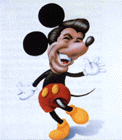
Robert Grossman, “Ronald Rodent”
During the late ’60s and early ’70s, the critical mass of Vietnam, Richard Nixon, and Watergate (as well as youth culture, feminism, and civil rights) gave artists a limitless number of issues and individuals to attack. There was not only Nixon, but Kissinger, Ehrlichman, Haldeman, et al. One prolific cartoonist described his work as shooting fish in a barrel.

Stephen Kroniger, “Uncle George Wants You”
But then came Nixon’s downfall. His resignation in 1974 resulted in a serious drought in political cartooning and caricature that lasted into the early ’80s. Without Tricky Dick to kick around anymore, accomplished cartoonists and caricaturists lost the best satiric target since Honoré Daumier lampooned the pear-shaped King Louis Philippe in the 1830s.
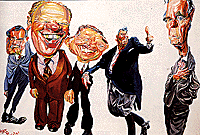
Philip Burke, “The Presidents”
The presidential blips of Gerald Ford (Nixon’s pardon aside) and Jimmy Carter (his private lusts aside) offered little in the way of visual inspiration. The resulting caricatures were comic, not poignant, and few were memorable. Even the early Reagan years did not prompt caricaturists into action right away.
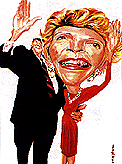
Philip Burke, “Ronald and Nancy Reagan”
As the ill effects of the Reagan presidency trickled down, however, the masters of political iconography persevered. When the Teflon wore off, Reagan stood revealed as a fine, upstanding caricature, his painted pompadour, craggy face, and stiff demeanor too enticing to ignore. And Nancy (the original Cruella De Vil) provided comic inspiration not found in the demure Pat Nixon. While he was no Nixon, Reagan spawned a minirenaissance, bringing forward yet another generation of caricaturists. Publications that had all but rejected political caricature during the intervening years began relying on satire once again.

Robert Risko, “Hidden Hoover”
The exemplars of the “new” caricature, although schooled in the ways of the 19th century masters, looked to the recent past — including Levine, Steadman, and “Spitting Image” (the satirical British TV series) — for inspiration. Philip Burke developed an expressionistic painting style in which the brush stroke, not any particular editorial idea or conceit, exposed his target’s character. Steven Brodner perfected a method, focusing on physical traits, that tore the facade off his subjects. And Sue Coe, whose visual essays often appeared in Mother Jones, used social realism and shocking grotesquerie to transform her bêtes noires into frightening monsters.
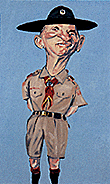
Philip Burke, “Ross Perot: Boy Scout Billionaire”
As Reaganism segued into Bushism, political caricature continued its rebirth. Theatrical and social caricature were on the upswing, too, and while these forms serve no cautionary or curative role, their widespread popularity and pertinence encouraged artists to readdress caricature as a viable graphic form. With politics in its current state, the more caricature the better — if only for a good laugh to deflate the buffoons.
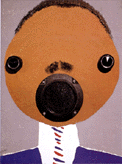
Hanoch Piven, “Jesse Jackson”
Steven Heller’s books include: The Savage Mirror: The Art of Contemporary Caricature (Watson Guptill); Man Bites Man: Two Decades of Drawing and Cartoons by 22 Comic and Satiric Artists (A&W Publishers); The Art of Satire (Horizon Press); and Art Against War (Abbeville Press).












